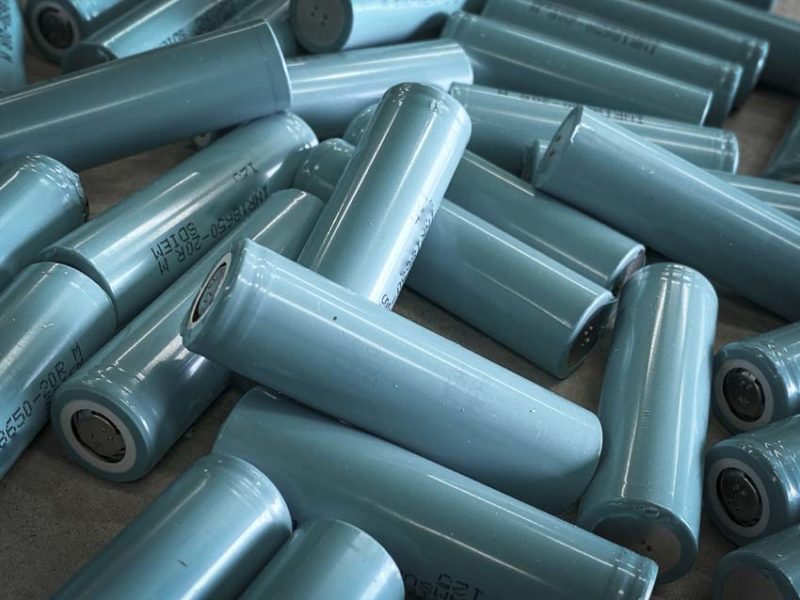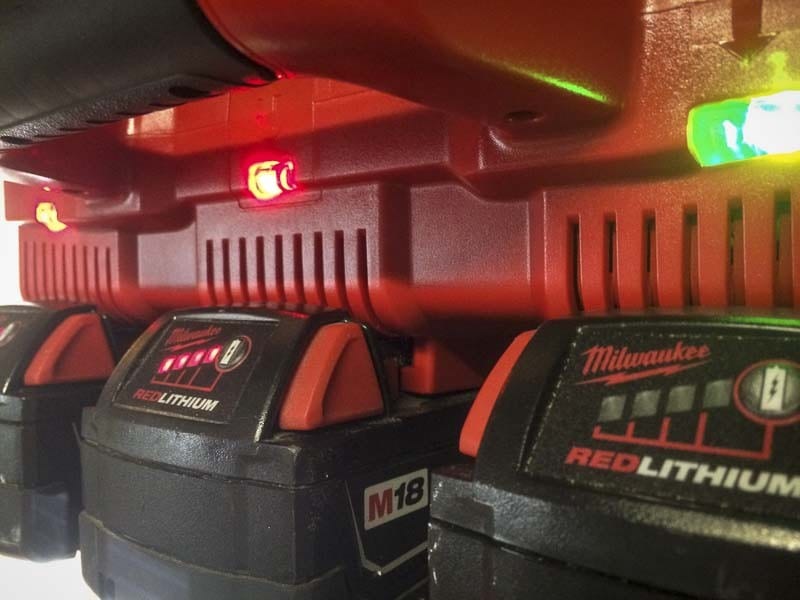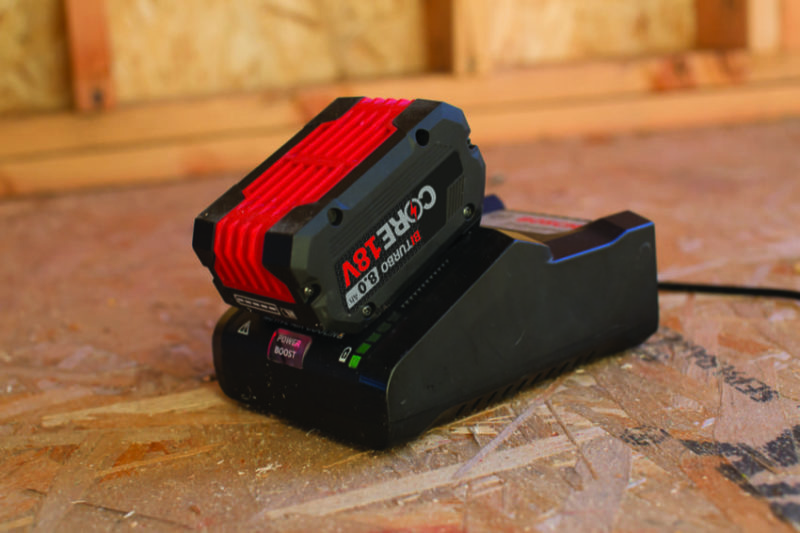Everyone seems to be on a diet these days. You can’t turn around without someone talking about their latest no-carb or calorie-counting escapades into the world of better living. Me? I’ll take the steak, medium-rare, with a side of onion rings. But one thing does seem to ring true: What you put into your body tends to significantly affect how it performs. If tools have “bodies”, then their “food” would be the amps put out by today’s lithium-ion batteries. The amp-hour and Watt-hour ratings of a battery have a lot to do with its potential for run-time. But there’s a lot more to the story of how lithium-ion batteries work…a whole lot more.
Editor’s Note: This article originally published in August of 2013. We made a few updates to take into account new advancements in technology.
How Lithium-ion Batteries Work
To help define exactly how lithium-ion batteries work, PTR independently interviewed two men we truly respect in the industry: Paul Fry from Milwaukee Electric Tool Corp and Jason Feldner from Bosch Tools. There are other experts, but we know these guys and have been fortunate enough to talk with them regularly over the years about power tools, batteries, and lots more. It’s hard to imagine two better sources to deliver the low-down on the mysteries inside those battery packs we use so regularly.
Pro Tool Reviews (PTR): How long have you been working with lithium-ion battery technology?
Jason Feldner (Jason): Well, when you say Bosch you have to include Skill, Rotozip, and Dremel, among others; and Dremel was really our first brand to utilize lithium-ion batteries. We made that battery pack in 2003, and it really met our purpose of achieving a smaller more compact solution that could hold the same power. Or, it could stay the same size and offer more power. In 2005, Bosch launched their 12V Max (10.8V) tools.
Reducing Tool Size and Weight
Jason: For the first time, lithium-ion batteries enabled smaller, more compact, tools to actually do like 80-90% of the work needed. A lot of driving applications simply didn’t require 18V tools…and this was a real wake-up call. The “pocket driver” was born. It really went from “Oh how cute” to “Wow, amazing!” To put the size in perspective, a 12V battery was essentially the size of the stem on the old stem packs. In 2008, Bosch introduced 18V lithium-ion battery packs. 36V packs also came out then, but the new power density really made 18V the key size.
Paul Fry (Paul): Milwaukee began researching alternative battery pack designs and chemistries, including lithium-ion, in the mid-90s. Years of development led up to the V28 platform in 2005. One of the key elements we found was that you can take the best lithium cell in the world, but if you don’t protect it, you can destroy it the first time you use it. V28 helped work through that process. It was the first pack to carry its own electronics, which extended the life of the pack. The biggest challenge for us involved understanding how lithium-ion batteries work to deliver the high current required throughout the discharge cycle.
How Lithium-ion Battery Technology Changes
PTR: Can you tell me how lithium-ion batteries work now compared to the technology from your 1st-gen batteries?
Paul: Well, the batteries changed, but also the industry changed. We had 2 production generations of V28 packs that used the 26700 cell—these big paper-wrapped cells. Then, we went through 4 generations of the 18650 variety of smaller cells in the M series beginning in late 2007. Overall, we’ve been through 6 generations. Milwaukee developed the first 4V 3Ah cells with E-One Moli in Canada. We quickly recognized that we needed a battery manufacturer to handle the volume.
What Drives Innovation in the Market
After that, we realized that our best position became to use our knowledge of lithium-ion to drive manufacturers to make better solutions for power tools. The 18650’s in the market today began because battery manufacturers started in energy cells (the batteries used in laptops). They wanted to expand their businesses. These same successful electronics companies quickly realized they lacked the equipment to make a power cell. They were in a high-volume, low-margin business, and the power cell market needed smaller quantities, but provided higher margins. Our industry ended up diversifying their businesses.
Editor’s Note: Check out the Milwaukee 12.0 Ah high-output battery for an example of the latest innovation. This represents one of the highest 18V power packs currently on the market.
Parts to a Whole
Jason: Lithium-ion technology has changed with regards to the role the battery cells play in the system. There are three components to a lithium battery pack: the battery cells, the electronics, and of course, the tool. For lithium-ion to function well, electronics are essential. They control the battery and the movement of energy. The very nature of the cell chemistry requires this. Ni-Cad cells didn’t need electronics
However, lithium-ion requires both the tool and the battery to communicate with each other. How that system works and communicates determines how the tool will function at its optimal level. These are the areas of advancement that are really changing the playing field. For Bosch, we’ve got the electronics in the tool, and there are minor electronics in the battery (mostly for identification).
Some companies have batteries they could place in existing tools. They just put the critical electronics in the battery itself. For Bosch, it made sense to come out with a whole new line of tools. Bosch theorized you had to design both the tool and the battery together in order for them to work optimally.
Designing Li-ion Battery Packs
PTR: How do you approach battery design—from cell selection to electronics and the actual packs themselves?
Jason: Certainly, you choose cells wisely, but to us, heat is the number one issue. Whether it’s your car, the human body, etc., heat is a big deal. For tools, the same is true, particularly with respect to batteries. The contacts deteriorate under extreme heat, so Bosch uses a built-in heatsink. If you look at the bottom of our packs, it has ribs on it that create more surface area for heat to leave the battery. On top of that, we engineered our packs to be durable and to survive drop tests.
Paul: Not all lithium cells are created equal. Battery manufacturers know how to make batteries, but they aren’t end-users. They may not understand the high current needs of those tools. So a lithium-ion manufacturer is capable of delivering a cell emphasizing certain traits. High capacity Ah or Watt-hours—they can do that. But just because it has the capacity doesn’t mean it can sustain the current.
Paul Fry on Energy Cells vs Power Cells
A cell is a cell, right…? Wrong. Lots of energy cells are designed for consumer electronics. This prioritizes capacity over current capability. In those scenarios, manufacturers placed very little focus on how the life of a cell depreciates over extended loads. Consumer electronics simply don’t produce as much current. These products also don’t see as much constant or rigorous use.
Cell specification can be radically different than what power tools might require. While the external ratings of a pack might look identical (4.0Ah, lithium-ion, etc.) the lifespan, power delivery, and current handling capabilities can be wildly different.

To put it in perspective, a typical 18V lithium-ion pack may need to sustain in excess of 20 amps throughout its discharge. This is the kind of high current required to drive a power tool. Compare that to a computer or other consumer electronics device whose energy cells demand only 3-4 amps!
How Electronics Let Lithium-ion Batteries Work Efficiently
PTR: How important are the electronics in modern Li-ion batteries?
Paul: Electronics really play a role in protecting the battery packs thermally. Take a lithium-ion cell in excess of 75ºC (167ºF) for a sustained time, and you will do permanent damage. Electronics regulate the system and protect your investment. They also handle discharge control—a new concept that came along with this technology. For Milwaukee, up until V28, you could discharge the pack as far as you wanted, but with V28 you couldn’t flatten the voltage in the pack.
Milwaukee’s V28 shut off the power right before you would cross that critical voltage line. Even in the late stages of Ni-Cad, when there were no real memory issues, people would still act as if there was, and they would run it all the way down. Because of the way the “death curve” worked on Ni-Cad that wasn’t good for the tool, but people still did it.
Cell Balancing and Voltage
Paul: So now the electronics also handle cell balancing, controlling how voltage goes in and out of the cell. If the cells get unbalanced you can get poor performance and then eventually do damage to the pack. To most people, the electronics are most evident with the new fuel gauges on the battery packs and tools, but it’s really in the areas of performance and durability that you see the big benefits.
Jason: Essentially the battery communicates with the tool at all times, and therefore, the tool knows exactly what it can do. We’re constantly monitoring the temperature on both the battery and the tool along with energy flow and the load. A difficult load means that the battery will step in and grant more power output. It also monitors for too much load, and it knows when damage or overheating will occur so that it can react accordingly to protect both the battery and the tool.
The charger also analyzes the battery, so that it knows what to do and when to stop. It will be able to engage in “front-loading” the charge and then top it off. This is sort of like how you fill your car up with gas or how you might fill your glass at the sink. You slow down at the end to avoid over-filling.

Bosch Tools on How a Cordless Power Tool Works
From the time the trigger is pulled to engaging a load, there is a lot that happens in a power tool. This is particularly true when the tool encounters a load that is beyond the capabilities of the motor, causing it to begin to overload or overheat. Then, there’s the battery discharging and charging process. Combine this with how and where the electronics are located, and you can see that these next-generation lithium-ion tools are not your father’s cordless tools!
The Cycle of Cordless Tool Batteries
If you want to try and understand, here’s how we break down what’s really happening:
- Slap the battery on the tool. The battery and tool say, “Hello,” and the electronics in the tool analyze the battery to determine how the tool can work with it. It knows whether this is a Slim or Fat pack and how much reserve it has in order to get the work accomplished.
- Pull the trigger. The temperature is checked at the battery. The tool asks, “How much energy can you give me?” while the battery queries, “How much do I need to do what you are demanding of me?” The tool continues analyzing the load, and the battery gives more (or not) based on heat and energy flow.
- Rinse. Repeat. This analysis of what can be safely delivered occurs over and over at the millisecond level to ensure the tool’s safe operation. Simultaneously, the electronics make sure not to discharge the battery too far.
- Charging. When a battery is placed on the charger, it’s analyzed. (Now, the charger, in effect, says, “Hello.”) The battery temperature is checked, and the pack is allowed to cool down before charging if needed. Charge time on a completely discharged battery may differ from a partially depleted battery due to the front-loading effect.

The Future of Lithium-ion Batteries
PTR: Can you tell us anything about where you see the future of lithium-ion battery technology moving?
Jason: Well, lithium-ion batteries are a technology that is constantly being watched. There is “what’s possible” vs. “what users need”. What was nice about our 4.0Ah lithium-ion batteries is that thanks to the sophisticated work we did on the electronics, the new battery didn’t require a complete redesign. Rather, it just analyzed the newly available power schedule and adapted the tool and battery accordingly. Basically, the electronics will understand that they can push harder or run longer. So the future is definitely improvements in cell chemistry and perhaps even gradual improvements to the way the tools and batteries communicate.
Paul: The challenge for manufacturers is that in the marketplace you’ll continue to see people pushing the far edges of what can be done. Car manufacturers are all over lithium-ion battery technology right now, and certainly, it plays some part with the green energy people. Take it all into account, and the maturing of lithium-ion batteries has a lot of potential. We’ll most certainly see a progression of capacity, but there will also be trade-offs that can be made with positive effects.
Editor’s Note: We saw this with the introduction of battery packs using 21700 cells from both of these manufacturers and orthers.
Currently, you don’t see power tools using prismatic cells (the non-cylindrical form factors), but there is probably room to go down that path. Three years ago, people would have said 12V and 18V 2.0Ah and 4.0Ah battery packs were a pipe dream. Now, gains in the manufacturing process and the new chemistries involved have allowed advanced packs like this to be made.
Wrapping It Up
We want to thank both Jason and Paul for agreeing to be interviewed about battery technology…Um, particularly since neither was aware we were interviewing the other for this article. (Don’t worry, we let them both check it out to make sure we got all our details correct.) It’s hard work and innovation from guys like this (and their teams) that help bring the tools we love to market.
If you are a product manager and have an interesting story to share about how a particular tool or technology works, please feel free to send us a note at editor@protoolreviews.com, and we can consider using it in a future article or contact you to get more information.





